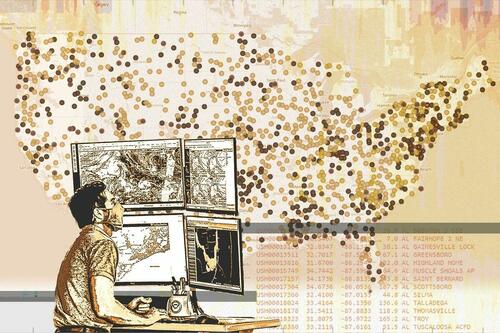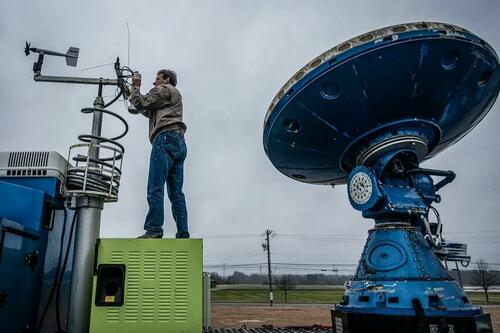Hidden Behind Climate Policies, Data From Nonexistent Temperature Stations
Authored by Katie Spence via The Epoch Times (emphasis ours),

The National Oceanic and Atmospheric Administration (NOAA) predicts July, August, and September will be hotter than usual. And for those who view warmer temperatures as problematic, that’s a significant cause for concern.
“Earth’s issuing a distress call,” said United Nations secretary-general António Guterres on March 19. “The latest State of the Global Climate report shows a planet on the brink.
“Fossil fuel pollution is sending climate chaos off the charts. Sirens are blaring across all major indicators: Last year saw record heat, record sea levels, and record ocean surface temperatures. … Some records aren’t just chart-topping, they’re chart-busting.”
President Joe Biden called the climate “an existential threat” in his 2023 State of the Union address. “Let’s face reality. The climate crisis doesn’t care if you’re in a red or a blue state.”
In his 2024 address he said, “I don’t think any of you think there’s no longer a climate crisis. At least, I hope you don’t.”
When recalling past temperatures to make comparisons to the present, and, more importantly, inform future climate policy, officials such as Mr. Guterres and President Biden rely in part on temperature readings from the United States Historical Climatology Network (USHCN).
The network was established to provide an “accurate, unbiased, up-to-date historical climate record for the United States,” NOAA states, and it has recorded more than 100 years of daily maximum and minimum temperatures from stations across the United States.
The problem, say experts, is that an increasing number of USHCN’s stations don’t exist anymore.
“They are physically gone—but still report data—like magic,” said Lt. Col. John Shewchuk, a certified consulting meteorologist.
“NOAA fabricates temperature data for more than 30 percent of the 1,218 USHCN reporting stations that no longer exist.”
He calls them “ghost” stations.
Mr. Shewchuck said USHCN stations reached a maximum of 1,218 stations in 1957, but after 1990 the number of active stations began declining due to aging equipment and personnel retirements.
NOAA still records data from these ghost stations by taking the temperature readings from surrounding stations, and recording their average for the ghost station, followed by an “E,” for estimate.
The addition of the ghost station data means NOAA’s “monthly and yearly reports are not representative of reality,” said Anthony Watts, a meteorologist and senior fellow for environment and climate at the Heartland Institute.
“If this kind of process were used in a court of law, then the evidence would be thrown out as being polluted.”
Critical Data
NOAA’s complete record of USHCN data is available on its website, making it a vital tool for scientists examining temperature trends since before the Industrial Revolution.
Jamal Munshi, emeritus professor at California’s Sonoma State University, wrote in a 2017 paper that because many of the stations in the USHCN, and their data, date back to the 1800s, they’ve been “widely used in the study of global warming.”
“The fear of anthropogenic global warming has generated a great interest in temperature trends such that even minute changes in the temperature record are scrutinized, and controversial implications for their effects on climate, extreme weather, and sea level rise are weighed against the cost of reducing emissions as a way of moderating these changes,” Mr. Munshi wrote.
“Energy and development policy around the world are impacted by these evaluations.”
Mr. Shewchuk said the USHCN data is the only long-term historical temperature data the United States has.
“In these days of apparent ‘climate crisis,’ you would think that maintaining actual temperature reporting stations would be a top priority—but they instead manufacture data for hundreds of non-existent stations. This is a bizarre way of monitoring a climate claimed to be an existential threat,” he said.
“Observed data is real. Altered and fabricated data is not real. Period.”
The website, noaacrappy, lists all of the ghost, or “zombie” stations, their location, how long they’ve been closed and then links to NOAA’s recordings.
Significantly, the map shows, not all of the stations used to interpolate temperature data are near the closed station. Thus, hypothetically, it’s possible that since Oklahoma City’s stations are all “zombies,” interpolation data is coming from as far away as Gainesville, Texas, which is more than 136 miles away, and Enid, Oklahoma, which is more than 100 miles away.
“For various reasons, NOAA feels the need to alter this data instead of fixing equipment problems they think exist,” Mr. Shewchuk said.
“Fixing temperature reporting stations is not rocket science. If we can go up to space to fix the Hubble telescope, we can surely come down to earth to fix a few thermometers.”
Read more here…
Tyler Durden
Thu, 04/11/2024 – 12:40
via ZeroHedge News https://ift.tt/Odn9EHZ Tyler Durden

